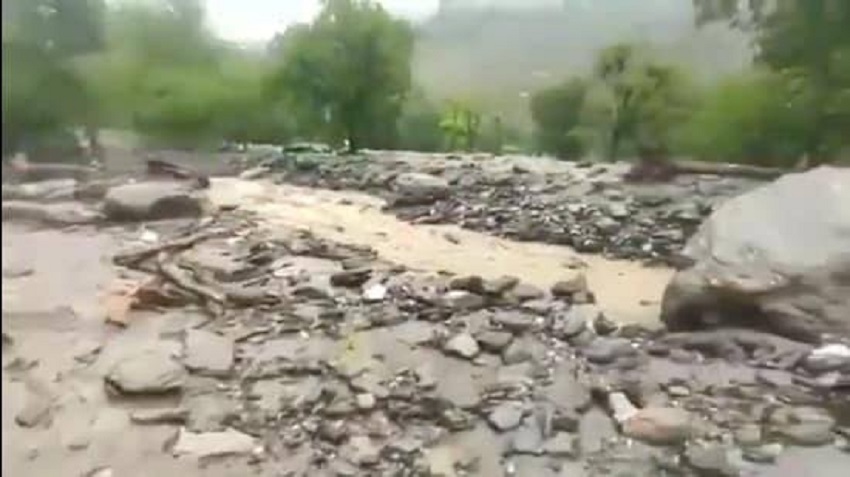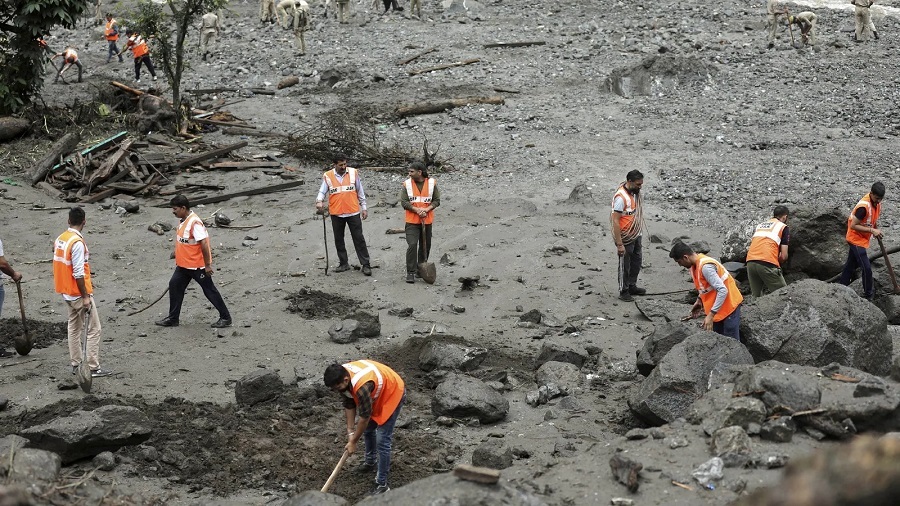
In the last decade, instances of cloudbursts have increased in the Kashmir valley and parts of Jammu especially in Chenab and Pir Panjal regions. Frequent cloudburst during summer rains is very dangerous and is causing flash floods.
One of the many reasons for the increased risks of such cloudbursts and flash floods is river bed mining which has weakened embankments of these streams which has in turn increased chances of flooding and waterlogging in surrounding apple farms.
Only a few days back, there was a massive flash flood in Romshi and Shali Ganga streams. Many local residents got trapped along with animals.
Both Romshi and Shali Ganga streams emerge from Pir Panjal mountain range. Romshi passes many areas after leaving from a Pir Panjaal glacier called Kach Goul locally. It passes through many areas of Pulwama like Rahmoo, Newa, , Pahoo and enters Jhelum near Dogam Kakapora area. Shali Ganga which is a tributary of Doodh Ganga originates from Tatakoti glacier in Pir Panjaal mountain range. It passes via Ashtar valley , Doodh Pathri, Raithan, Hushroo, Panzan and joins Doodh Ganga near Wathoora Budgam. The Doodh Ganga further joins Jhelum river around Wullar lake. In the past when flood spill channels were not constructed (Prior to 1917), Doodh Ganga would enter Jhelum after crossing Barzulla, Aloochi Bagh , Batmaloo and Chazbal area.
In the Panzan area of Budgam, the retaining walls of Shali Gana were washed away and there were a lot of landslides as well. The frequency of cloudburst has increased because of global warming. This is going to worsen in the years to come as the temperatures continue to rise every year.
As rising temperature in the Himalayan region and its impact on atmosphere which leads to cloudbursts is still being studied and researched, experts say that the warming Indian ocean is certainly carrying more moisture-laden winds towards the mountains of Himalayas which is causing cloudbursts in the Jammu & Kashmir, Himachal Pradesh, Uttarakhand.
This is a complex process and scientific evidence on this subject is still evolving and there are different views of weather experts/earth scientists on this issue.
What is a Cloudburst?
Cloudburst is a sudden and very heavy rainfall which is often local in nature and very brief in duration.
Cloudbursts usually occur in association with thunderstorms. In these storms, there are violent rushes of air which at times prevent the condensing raindrops from falling to the ground. A large amount of water may thus accumulate at high levels and if the upward currents are weakened, all of this water falls at one time. This is also called Aaab Thrath in Kashmiri dialect, while lightning is called Naar Thrath (Fire Burst) in our local dialect.
As explained above, cloudbursts are common in mountainous areas. This is probably because the warm air currents of a thunderstorm tend to follow the upward slope of a mountain. The effects of heavy rain are especially striking on mountain slopes because the falling water is concentrated in valleys and gorges.
Cloudbursts are very difficult to predict as they are very localized events. It means that the instruments to record cloud formation and precipitation have also to be distributed across a wide area for receiving the localized information. Even though the cloudbursts warning cannot be given in advance, the weather stations and experts do send alerts for a heavy rainfall
Mountain cloudbursts cause sudden and destructive floods and these we are witnessing off and on in Kashmir valley, Poonch, Rajouri, Ramban,Doda and Kishtwar areas of Jammu.
The sudden rise of water level in Romshi, Shali Ganga and Doodh Ganga on Sunday morning to afternoon was due to cloud bursting in Pir Panjal mountains.
Weak embankments
Flooding of rivers. nallahs and streams of Kashmir is an annual phenomenon and in the past 4 to 5 years there isn’t a single year when the state did not experience waterlogging and flooding in various areas. Maybe the intensity of these floods is small as compared to September 2014 floods but we cannot say that there were no floods at all.
Kashmir valley especially has witnessed many floods in the last 200 years which caused unprecedented damage and loss of lives.For instance, Kashmir valley witnessed major floods in 1841, 1893, 1903, 1929, 1948, 1959, 1957 , 1992 and 2014. Infact, Govt created many embankments around Jhelum and other small streams like Romshi, Doodh Ganga, Shali Ganga, Vaishav but due to illegal Riverbed Mining and constant movement of trucks, cranes and JCBs around these nallahs, streams and rivers, the embankments have been weakened and this is also leading to floods and water logging in the areas.
An embankment (levee) is an artificial bank built along banks of a river or stream to protect adjacent land from inundation by a flood. It is usually earthen and parallel to the course of a river. The embankments or ‘bunds’ vary in nature and function under a variety of situations. Many embankments are made of compacted soil especially in Indian plains but in Himalayan states especially J&K the embankments in upper reaches are made from boulders, stones and sand as well.
After the September 2014 floods in Srinagar and other areas of J&K, the Government of India sought assistance from the World Bank. A project namely Jhelum Tawi Flood Recovery Project was started in J&K with main focus on restoring critical infrastructure. As J&K is prone to natural disasters like floods and earthquakes the infrastructure under this project was supposed to be designed with upgraded resilient features, and included contingency planning for future disaster events. After 8 years of the devastating floods and funding having been allocated by the World Bank, it seems things have not been moving in the right direction.
Inquiry into Tawi Barrage
Under flood mitigation programme Jhelum and Tawi Flood Recovery Project, the Government took up construction of Tawi Barrage artificial lake project around 2016 in Jammu. This project, according to the Govt, will boost the tourism of Jammu city as modern and advanced means of recreational activities will be established in the city with the completion of this project.
However, this project was marred by corruption and mismanagement. A special audit ordered by Govt in the past had not only found glaring irregularities in the execution of the Tawi Barrage project but fiscal violations and financial impropriety of grave order which needed immediate attention of authorities concerned. Last year, the Government ordered that Mr Shaleen Kabra, Financial Commissioner, Revenue, J&K be the Inquiry Officer to conduct an enquiry in the matter of balance work (Civil, Hydro Mechanical, Electrical) of Tawi Barrage project. The Inquiry Officer was supposed to conduct detailed enquiry into the cost and time overrun of the project and he was supposed to submit a detailed report within a period of one month according to the General Administration Department’s order No: 838-JK (GAD) of 2022 Dated 15.07.2022, but even after a year the inquiry report hasn’t been made public and nobody was taken to task.
The Govt of India released Rs 140 Crores for Jhelum flood augmentation a few years back but it is still not known whether any tenders have been issued.
In case of Doodh Ganga, the Govt assured the National Green Tribunal -NGT last year that Rs 149 crores would be spent for setting up Sewerage Treatment Plants (STPs). Yet, even after a year, the tenders haven’t been issued.
On May 30th this year, the Principal Secretary Housing and Urban Development Department Mr Prashant Goyal was given 2 months by NGT to start the work execution. The matter is again listed for August 16th 2023.
The Jhelum and Tawi flood recovery projects were aimed at restoring essential services disrupted by the floods and improving the design standard and practices to increase resilience but when we see flooding happening off and on it seems things this project has not done any justice on the ground.
Conclusion
We cannot stop cloudbursts and flash floods from taking place as they are natural disasters but the Govt can definitely make sure these floods don’t cause destruction of life and properties.
By allowing JCB and L&T cranes to excavate riverbed material from our streams and constant movement of huge trucks,tractor trolley, dumpers and tippers,the embankments of streams like Romshi, Rambiara, Doodh Ganga, Shali Ganga, Vaishav have been considerably weakened.
The respective District Mineral Officers- DMOs are responsible for it. This illegal practice in Doodh Ganga and Shali Ganga in Budgam has been stopped for more than a month now after National Green Tribunal -NGT’s orders but why aren’t District Magistrates and District Mineral Officers (DMOs) of other districts enforcing the orders of NGT in their respective districts?
Even the Minor Mineral Concession Rules 2016 forbids use of machines and cranes to undertake riverbed mining but unfortunately those Govt agencies who have to enforce these rules are allowing its violation brazenly.
- Views expressed in the article are the author’s own and do not necessarily represent the editorial stance of Kashmir Observer
Follow this link to join our WhatsApp group: Join Now
Be Part of Quality Journalism |
Quality journalism takes a lot of time, money and hard work to produce and despite all the hardships we still do it. Our reporters and editors are working overtime in Kashmir and beyond to cover what you care about, break big stories, and expose injustices that can change lives. Today more people are reading Kashmir Observer than ever, but only a handful are paying while advertising revenues are falling fast. |
| ACT NOW |
| MONTHLY | Rs 100 | |
| YEARLY | Rs 1000 | |
| LIFETIME | Rs 10000 | |













